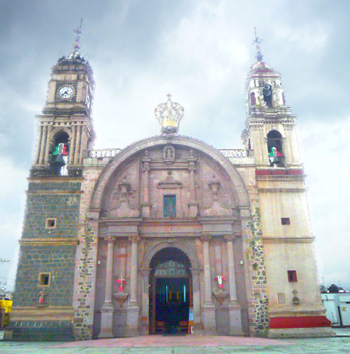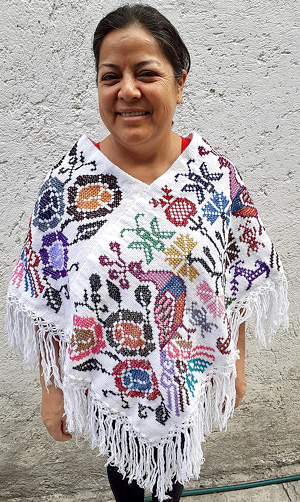(around 1994)

Church of Guadalupe (or Gualupita) Yancuictlalpan, in 2010; copyright free image courtesy of "Arqnigel" made available through Wikimedia Commons.
From Toluca, about thirty miles west of Mexico City, I take an early bus eastward across the chilly, dusty valley floor, and after about twenty miles come to Tianguistenco, at an elevation of some 8,800 feet. On Tianguistengo's outskirts I ask to be let off at the road to Gualupita Yancuictlalpan. After walking five minutes I enter a pretty little town with an ancient-looking church, a placid park, streets still deserted at 9 AM, and an inordinate number of tourist shops selling all kinds of brightly colored, 100%-wool, locally produced sweaters, ponchos, serapes, and other cold-weather clothing. I had expected this; Gualupita is known throughout Mexico for the woolen goods its artisans produce.
The whole landscape east of town tilts upward, eventually culminating at volcanic summit of the mountain chain called the Cumbres de Ajusco, rising like a north/south-running wall between Toluca and Mexico City. Sheep have grazed the slopes around Gualupita for centuries, bestowing their wool on Gualupita's weavers, but also causing a monumental ecological disaster; now the vast slope lies barren and eroded, just rocks, dust, and closely cropped grass.
Gualupita is a town obsessed with weaving wool. In a courtyard a woman quietly sits beneath a pepper tree fashioning a lacy ribbon, surely to be added later as the ornamental fringe of a poncho or serape. At the next house the bitter odor of cooking dye wafts onto the sidewalk. At the next, a loom's wooden parts systematically knock against one another.
In the courtyard of the next house I ask an old man doing something with a pile of serapes in the shade of a splotchy-barked eucalyptus tree if he will talk with me about his life of working in wool. He declines, but says his neighbor is one of the town's best weavers, and he is somebody who talks to people like me. I am directed down the street to a small wooden door in an adobe wall along the sidewalk. I rap, the door opens into a lovely courtyard, and am greeted as if I had been expected.
Señor Fidel Nava Medina, looking in his late fifties, at the very moment has ended his breakfast and is leaving for his day's work. I am invited to accompany him across the street, where he unlocks and opens a roll-up, corrugated steel door. Inside a room maybe fifteen feet by ten, a large, wooden hand-loom spares little space for anything but itself.

Señor Fidel Nava Medina, around 1994
Sr. Nava slides onto a wooden stool behind the loom, his back assumes a certain comfortable looking curvature, and his hands automatically reach for the shuttle. He begins mechanically passing the shuttle with its weft through the warp threads; the pass finished, he firms up the new weft by moving the comb forward. As the big loom passes through its maneuvers, it makes the wood-on-wood sounds I've been hearing from dozens of houses this morning. The movements and sounds seem to mesmerize Sr. Nava. After a lengthy period of work, he suddenly stops, looks at me, smiles, and says that we can talk as he weaves.
"I've worked in wool for about fifty years," he says in an almost gentle voice. "Yo fui bien joven cuando aprendí -- I was really young when I learned. And when I began, my older brother already knew the work, so it was he who transmitted to all us brothers the teaching. He had learned it all from a good friend... yes, a very good friend. But my brother died in 1952."

Señora wearing a quexquémitl, in 2019; copyright free image courtesy of Eduardo Ruiz Mondragón made available through Wikimedia Commons.
The memory of his brother's death throws a shadow across Sr. Nava's face, and a deep furrow across his forehead. But he keeps talking, explaining that right now the piece coming to life in his loom is a mañanita para señoras, a woman's pretty little thing, something traditional for which the Spanish had no name, so today the original Aztec word is used; it's a quexquémitl, something like a poncho with a hole in the middle for the head, but made to be worn with the sharp corners descending in front and back.
"Most people in this town work in wool," he confirms. "But, basically, there are just three families doing the most important work. We make serapes, torinas, mantles, capes, ponchos, all kinds of things, and of course we all have the maximum of pride in what we do. I've been in Oaxaca, I've been in Querétaro, and I've been in museums where they displayed handicraft like ours, and they had some good things, but there was never anything to compare with what we produce. It's always simpler than what we produce here in Gualupita."
I ask him if he does more than work at the loom -- if he knows the entire process of turning raw wool into beautiful textiles.
"What a joke it would be if I didn't understand the whole process," he laughs. "The carding, the thread-making, the dying, the weaving, the marketing, we must know how to do it all. We have neighbors with sheep, so we buy their wool, and do everything needed to turn the wool into our goods."
I ask about the origin of designs he weaves into his creations.
"Some are our own, but others we borrowed from the great masters who don't weave any more, and maybe a few come from others in this town who know as much or more than we do of this art."
Does he use natural dyes?
"Some people do use natural dyes," he says. "Natural colors aren't as bright as those produced with industrial dyes, but they do last for the life of the material. And, well, the store-bought dyes we're using are permanent, too. Some of our dyes are made in Germany. Look, here's a picture of a cape that's forty-five years old, and its colors are just as good today as when new."
Where are the woven items sold?
"Some are sold around here, but its more common for us to sell wholesale, in bulk. That doesn't mean that you can find our work in any tourist store. There are only a few of us doing this work by hand; what's sold in stores is usually mass produced by machines, and that's simple work compared to ours. Our work is superior to factory work because the colors last longer and the material is finished better. The threads in commercial textiles are a lot more loosely woven than ours. Ours threads are very compact, so the material will last for twenty-five years or longer."
How can someone who is not an expert determine the quality of a woven product found in a tourist store?
"Mainly, look to see if the threads are woven compactly. Only a weaver paying attention to every thread can create a textile woven the way it ought to be. Beyond that, the most important thing is whether the dyes are fast."
But how can we know that?
"You just have to ask, and have faith in the clerk. You just have to hope that if the colors are likely to fade, the clerk will say, 'Well, frankly, we can't guarantee these colors.'"
How long does it take to weave these items?
"This quexquémitl I'm working on takes a week to finish. Others with more detail can take two weeks. This one will bring me U.S. $200 to $230, while the ones with lots of designs bring around $300. And when I speak of weeks, I am referring to long days. Especially when we're behind in orders, I can work twelve to fifteen hours a day, or even more. There are times when I sleep only three hours a night."
Do the often-repeated motions needed for weaving damage the body?
"Besides tiring the arms and shoulder, this work produces dust that damages the lungs. When we make thread there's so much dust that we must wear masks."
Finally I wonder if Gualupita's wool-weaving tradition may be a disappearing art.
"Well, maybe this possibility exists. In our family we have two nieces studying how to do this work, but the other young people prefer book study -- they hope to work in offices instead of breaking their heads with this weaving. Yes, there's a real chance that when my brother and I die, and the other weavers in town die, the knowledge of how to produce this art will die out. This work is pretty, very pretty, but it is tiring, very tiring."